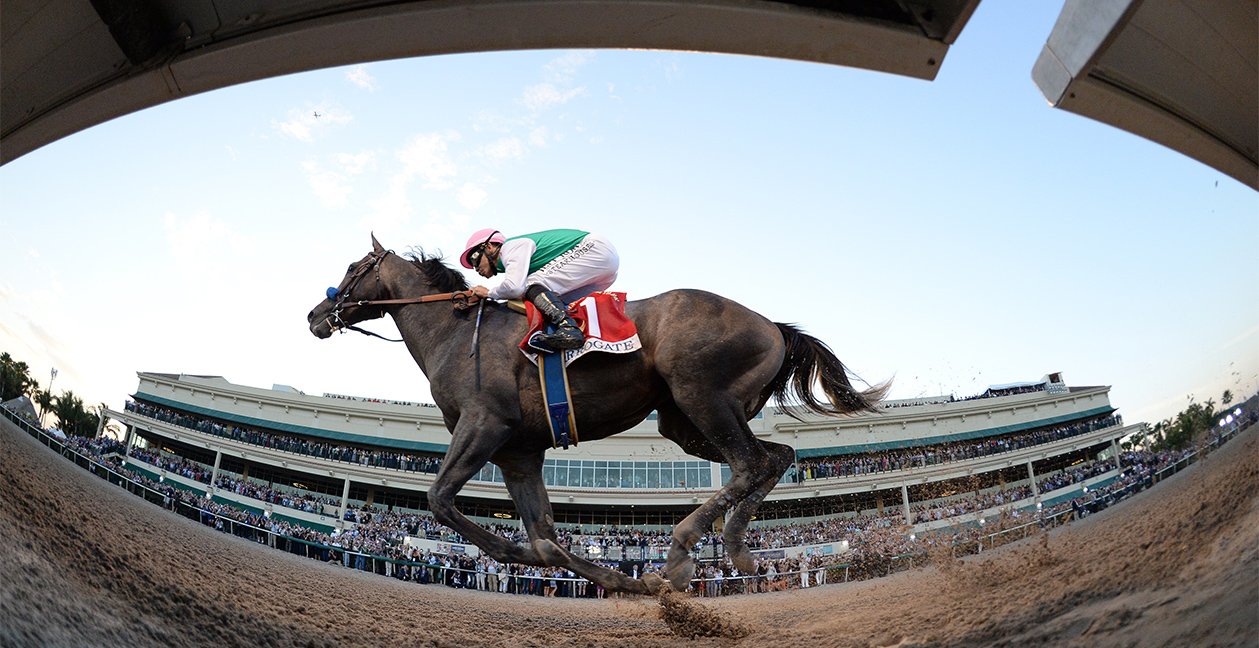On a warm evening this past January near Miami, Jennifer Lopez stopped the show. But this wasn’t the Super Bowl. At the Pegasus World Cup, a top-level thoroughbred horse race with a combined purse of $3 million that takes place annually at Gulfstream Park near Hollywood, Fla., the seventh race of the day had been delayed by a few minutes when the pop star made a surprise appearance with her husband, Alex Rodriguez, and their children. Other celebrities and society figures also attended the event, either viewing the races from the elegant Flamingo Room at the top of the stadium or from a private suite. That same day, just an hour’s drive north, a similarly well-heeled, if less flamboyant, crowd gathered at the Palm Beach International Equestrian Center in Wellington to watch top equestrians, such as Jessica Springsteen—the Boss’ daughter—and Olympic silver medalist Kent Farrington, compete in the FEI $137,000 Adequan Grand Prix CSI3* jumping competition.
While both of these events attract wealthy and world-renowned spectators stirred by a passion for horsemanship, their audiences, the horses and the world surrounding these sports are vastly different. Yet, in both cases, the excitement of each event often leads some fans to become more involved—usually in the form of horse ownership.

There are many reasons to buy a horse. There are approximately 2 million horse owners in the U.S. and roughly 7.2 million horses, according to the Washington, D.C.-based American Horse Council. Of those, about 2.5 million are racing and showing horses, with the rest destined for leisure or work. But generally speaking, high net worth individuals buy horses to either participate in the racing world—providing investment opportunities and a ticket to a lifestyle of glittery gatherings such as the Pegasus World Cup, Royal Ascot and the Kentucky Derby—or to engage in showing as either a rider or a sponsor, which also provides VIP access to lavish events such as the Winter Equestrian Festival, the Palm Beach Masters and the Royal International Horse Show. “Owners know they may not get their investment back, but they’re going to have a heck of a time being in competition with a horse,” says Robert Elliston, vice president of racing and sales at Keeneland in Lexington, Ky., the world’s largest thoroughbred auction house and host of this year’s Breeders’ Cup race in November. “You can have fun with other like-minded people.”

However, horses are complex animals in a costly and fragmented industry. What to look for in a horse varies greatly according to its intended use, but no matter your preference, the biggest keys to success are surrounding yourself with trustworthy professionals and gaining deep equine knowledge. Consider this a mere primer on what you should know.
Figure Out Your Goals and Know Your Limits
Before you even begin looking for horses, determine why you want one. Not only do racing and equestrian sports attract different fans, but they deal with entirely different animals and industries. A racehorse is not a dressage horse, a dressage horse is not a show jumping horse, and a 6-year-old jumper is not the same as a 12-year-old.

“You don’t want to buy the wrong horse, because horses are very easy to buy and very difficult to sell,” says Jane Jennings, a prominent horse agent and trainer with facilities in Aiken, S.C., and Cochranville, Pa., who deals mainly in sport horses—those bred for Olympic disciplines, such as dressage, eventing and show jumping. These horses can sell anywhere from $5,000 to hundreds of thousands of dollars. They trade primarily on experience and training, not heredity, so what is suitable for any given rider varies according to their own skill, or lack thereof, as well as their budget. “Buying horses is a risky endeavor,” she says.

That sentiment also applies to racehorses, in which the financial risk is greater—these animals typically sell before ever stepping onto a racetrack, commanding prices that range from $7,000 all the way to tens of millions—and the chances of a return are slim. The goal in racing is mainly to back a prizewinner, which is why pedigree is so important here. “One of the indications of future success is a pattern of demonstrated success in the past,” says Elliston. But there is a world of options for investing in a racehorse. Investors can choose to buy mares to mate with stallions, producing a horse each year that could be sold at 6-months-old as a weanling, or raise it to 15 months and sell it as a yearling. Another option is pinhooking—buying yearlings, training them and reselling them as race-ready, 2-year-olds for, hopefully, a profit. “The risk profile varies and it all depends on the manner in which an individual would like to deploy their capital,” Elliston explains.
The moral here is to know exactly what your intentions are before buying a horse. It’s the only way to determine your next steps as you wade your way through a broad marketplace of options.
Prepare to Pony Up
It’s common knowledge that show-level and racehorses aren’t cheap, but “the purchase price of the horse isn’t always going to be what is most expensive,” says Kent Farrington, an Olympic silver medalist who is currently the number one show jumper in the U.S. and one of the top 10 in the world. “It’s the nonstop caring that is very high.”
Basic needs for show horses include boarding, feeding and grooming, health management, monthly shoeing, as well as veterinarian and dentist costs. According to Jennings, these costs vary according to location and how fastidious you are. Boarding can range between $500 to $1,000 per month, with fancier barns that provide more amenities charging more; shoeing can cost anywhere from $125 to $500 a month. If you’re competing at a high level, a vet should examine the horse at least every month to prevent or treat injuries and vaccinate it twice a year.
Additional costs to consider—if you plan on competing in the sport yourself—are training for the horse (“If you can’t afford training, don’t buy a horse that requires it; don’t buy a young horse,” Jennings says), classes for yourself ($75 to $250 per hour, depending on the instructor and his or her qualifications), entry fees to shows (anywhere from $50 to more than $1,000) and shipping and stabling costs when going to a show. The more elite of a rider you become, the higher your expenses. “For an international competition horse, just the cost of a one-way flight to Europe is easily $10,000,” says Farrington, “so that can rack up pretty fast. From being based in the United States and campaigning international horses, my running costs could be around $100,000 for one horse.”

For racehorses, the care differs a little—more frequent veterinary checks and exercising—and the costs are slightly higher. Keeneland’s Elliston says that caring and training for a horse will average $40,000 a year, “assuming that everything goes well, and not counting veterinary bills or surgeries.” And if you have a mare waiting for babies to be born, the cost may be $25,000 to $30,000 a year. Vet checks can cost several hundred dollars each visit, and surgeries are anywhere upwards of $5,000, depending on the type.
Will that investment return a profit? That’s hard to say. In equestrianism, the primary purpose of a buying horse is to practice the sport or to help someone who does, so the returns are mainly in your own enjoyment. “Some people do buy horses with the intention of reselling,” says Jennings. “They’ll buy a young horse, put two or three years of experience into it, and then they’ll sell it hopefully for a profit. But that person is not an amateur. It is someone who has years of experience.”
On the other hand, in racing the endgame is all about profit—though the odds are against you. “That’s what you hope to regain in the end for each horse: the purchase price and the expenses that you’ve invested,” Elliston says. “But if you get into a situation where you’re fortunate to buy a yearling that turns out to be a Derby winner, all of a sudden, that $450,000 payment you made for that horse and the racing money turn into syndicating that horse as a stallion for $25 million—that does happen.”
There are also marketing opportunities which help to offset some of the costs of ownership. For example, private aviation company Sentient Jet has sponsored at least six championship racers since 2016, including Country House, the controversial winner of 2019’s Kentucky Derby. “I’d never been in a winner’s circle where half the people cheered and the other half booed,” quips Sentient Jet CEO Andrew Collins, who values the synergy between the racing world and his client base. “We have this ecosystem of people we have teamed up with because it is an affinity for our jet card owners.”
Arm Yourself With Advisors You Can Trust
Buying a horse is like buying a used car, says agent and trainer Jennings. “There can be a lot of embellishment—some people who will do pretty shady things to make a sale,” she warns. Horses can be given pain-masking drugs, for instance, to appear healthy in photos, videos and even in person. They can also be ridden prior to a meeting to appear more docile. These are all things that trainers, like Jennings, know are important to look out for. So, the first rule is to get yourself a good trainer to guide you. (For thoroughbreds, this role would go to a bloodstock agent.) Trainers not only have a network of professionals but also understand what kind of horse is best for your skill level. “It all goes back to trust,” adds Farrington, “working with reputable people and having a strong network of sources.”
And let’s face it: Unless you have an advanced degree in equine studies or decades of experience in the horse industry, you probably don’t know enough to buy a horse on your own. “Even at the point where I am now, we still make mistakes,” says Colombian–born Daniel Bluman, a show jumper ranked 30 in the world who is set to compete in this summer’s Olympics for the Israeli equestrian team. He has been around horses since age 3 and estimates he’s owned around 50. “You don’t want to end up getting a horse that is lame,” he says, referring to a dysfunction in the horse’s movement due to physical or neurological abnormalities. Engaging a trusted veterinarian is crucial.
The process of privately buying a sport horse is straightforward and surprisingly fast (“It’s a finite market, and a good horse will go quickly,” Jennings says), but requires many inspections. Once the vetting process begins, the horse is typically taken off the market. An independent vet initially performs a clinical exam. If cleared, the horse then receives up to 80 X-rays and further exams, such as ultrasound scans of joints and organs. “There’s always a type of risk involved—no vetting is ever perfect. My job is to help buyers decide on a level of risk that they’re willing to assume,” Jennings explains. This process shouldn’t take more than a week.
Another option is to attend a horse auction, where things move even faster. For example, The Ten—an event that takes place in North Salem, N.Y., and Lier, Belgium, that curates 10 promising high-caliber horses and brings them to potential buyers at elegant nighttime galas—sold its horses for a total of more than $4 million in less than two hours. This kind of auction removes much of the preliminary work for buyers but also commands higher prices. “The advantage is that because it’s so public and everybody is looking at it, you know that the horse you are getting has to be legitimate,” says Bluman, who is part of the team who organizes the event and vets the horses. “It gives you a sort of insurance.”

For thoroughbreds, one of the top places to go is Keeneland in Kentucky, which sold more than $625 million in horseflesh last year. However, buyers here get more involved before bidding begins. Buyers’ vets and bloodstock agents check the horses, submitting them through batteries of exams and scans, in addition to checking over the records provided by owners. Once the horse is brought to the arena for bidding, the process resembles the heyday of stock exchange floors; there may be 500 to 600 people making bids, with each sale taking 45 seconds to a minute. Ownership transfers at the drop of the hammer. “It is the purest form of capitalism, putting buyers and sellers together in a controlled marketplace,” says Elliston. While the average price of a horse here is just under $100,000, last year’s top sale (which lasted four and a half minutes) came in at $8.2 million for a yearling.
Weigh Your Options
As with most other niche industries, horse ownership has democratized to a degree since the costs are so high. “That’s the brutalizing part of our sport,” says Aidan Butler, chief strategy officer of the Stronach Group, the largest owner and operator of racetracks in North America, which runs well-known venues such as Pimlico in Baltimore, Santa Anita outside of Los Angeles and Gulfstream Park near Miami. “It’s very difficult to be competitive because it’s very bloody expensive to keep buying horses on your own.” Though ownership of a competition or racehorse may be more accessible to ultra high net worth individuals, you can enter into business partnerships, usually between four to five people, to co-own a steed and share all the expenses. Though this scheme lowers the barrier to ownership, at the racehorse level we are still talking about a six-figure investment. “The problem is you can be the smartest horse person in the world and spend a lot of money, it still does not guarantee you success or even a good outcome.”
A response to this problem is syndicates, commercial enterprises that have grown in popularity over the last decade in both horse racing and equestrian sports. In a syndicate, a larger group of people (usually 10 to 12) come together to purchase a horse. Each person’s fraction covers the actual price, as well as annual maintenance costs. This scheme allows an individual to spread their investment across several horses, like an index fund or an ETF, increasing the chances of success. And as an interest owner, he or she doesn’t have to worry about vets, training or the day-to-day care of the horse, but still enjoy the perks that come with ownership, such as VIP passes, access to riders and invitation-only events. “It’s a great way of participating because you can support a rider you like and whom you know is working really hard,” says Jennings. For the racing community, it also brings in much-needed new investors. “Our game survives on the stakeholders, not necessarily the participants,” says Butler. “They ultimately fund the vast majority of our sport.”
An even lower entry point has appeared in the last year, at least in racing. Thanks to a 2015 SEC decision to allow the selling of securities through crowdfunding, California–based app MyRacehorse has begun selling micro-shares of horses. In brief, the company buys a percentage of a horse and divides that into smaller shares that app users can buy for as low as $95. Though this option doesn’t usually come with any kind of access to the horses themselves, equity shareholders do receive a portion of any prize winnings. “You can come in for as little as you want,” says Butler.
If after examining the myriad horse sport options you decide that you just want to own a horse to ride for leisure, the choice is simple. “Adopt one,” says Bluman. “If all you want is a horse to enjoy, you should not spend a dollar on it. Get one from a rescue—donate a little bit of money, and they’ll give you a horse you can have fun with.”
///
Getting Started
Interested in owning a horse? These six resources will help you learn more.
American Horse Council, an equine industry trade group based in Washington, D.C. horsecouncil.org
Jane Jennings, a prominent equestrian agent and horse trainer based in Cochranville, Pa., and Aiken, S.C. [email protected], 609.462.6034, janejenningsequestrian.com
Keeneland, the world’s largest thoroughbred auction house. 859.254.3412, keeneland.com
MyRacehorse, an app that sells micro-shares of horses. myracehorse.com
The Ten, an auction of elite sport horses that takes place in Belgium and North Salem, N.Y. the-ten.com
13 Hands Equine Rescue, a Bedford Hills, N.Y., horse rescue. 914.325.4941, 13handsequine.org









